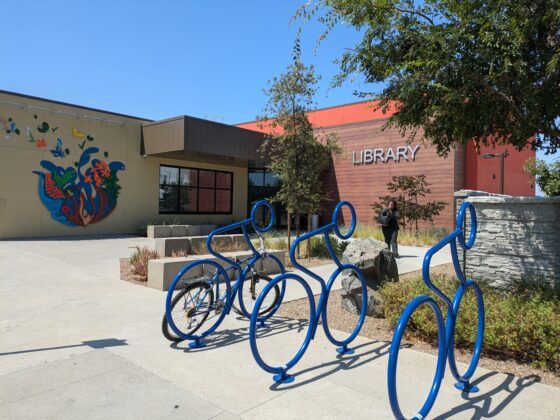Even before librarians closed their doors against the pandemic, they started moving fast to keep their work going. They began shifting regular programming online; distributing stockpiles of mobile technology to the digitally needy; strengthening partnerships with schools and food donation sites; activating their maker-technology to produce PPE; helping prepare the homeless population with alternatives for shelter; and more. I wrote about libraries’ novel response to the novel coronavirus here.
The ideas keep coming. Pick-up and drop-off services are emerging. The Alexandria, Virginia, public library offers curbside book pick-ups for their community. The Hillsborough County library in Florida opened a drive-through pickup for reemployment-assistance applications. People can also drop them off when completed, and the library will mail them.
In Arlington, Virginia, the public library has already published several online issues of Quaranzine, a community-sourced collection of artwork, poetry, photos, and stories about life during the pandemic.
The Hartford Public Library in Connecticut has moved their immigrant services online, including providing legal help to complete citizenship applications and prepare for citizenship interviews.
Serendipitous moments spur other ideas. When researching the Raymond M. Blasco Memorial Library‘s history for the upcoming annual report, Blane Dessy, the new director of the Erie, Pennsylvania, library, came across the annual report from 1918, documenting that the library had shuttered before—during the influenza pandemic. It inspired Dessy to begin working on an Erie County COVID-19 print and digital archive for future reference. “Here we are again,” he wrote me in an email, “and it strikes me that this pandemic will be an interesting story in the history of libraries in the United States.”
Librarians are also thinking about how they will serve their communities once they open their doors again. Here are some of the comments I’ve heard, from the April 16 program from the Public Library Association’s (PLA’s) series of webinars, from communications with the Urban Libraries Council, and from some of the many librarians I met with over the past seven years during my travels around the U.S. with my husband, Jim, for The Atlantic and ultimately our book, Our Towns: A 100,000-Mile Journey into the Heart of America.
Looking back to the present and future: The old-school telephone is back. Realizing that many seniors who showed up in person at the libraries aren’t comfortable moving online, Anythink Libraries, a district of seven libraries in Adams County, Colorado, have staffed up their midday hours to man a telephone call center. Users can call to “just say hi” or talk about what’s on their minds. The message the library wants to convey even during the pandemic, according to the director Pam Smith: “We are here for you.”
Many school systems and the libraries that work with them have identified the gaps in how schools deliver their distance learning to their students. Many families lack the hardware or internet access or familiarity with technology to help their children do their schoolwork. Marcellus Turner, the executive director and chief librarian of the public library in the tech mecca of Seattle, talked about starting to fill in all those pieces to put more hardware in the hands of more students, offer more connectivity through Wi-Fi hotspots, and more tech help to guide newbie households through the processes. And in the meantime—there is always a meantime—they are filling the space with actual telephone calls to students who used to show up at the library for homework help to ask how they can help over the phone.
And remember scrapbooks? The Anythink Libraries are moving their summer reading program, called mySummer, out of the libraries and into the houses, treehouses, tents, homemade forts and backyards of its readers. “It is all about inventing your summer which includes reading, thinking and doing,” Director Pam Smith wrote me in an email. The library is distributing notebooks and kits of crayons, chalk, and other items to anyone—young or old—who signs up for the program. They’re encouraging the “authors” to list the books they are reading and describe their summer adventures, to make artwork, take an imaginary trip, write about critters they find in nature, and lots of other ideas to spark creativity and imagination.
Ramping up the virtual: Despite everything horrible about it, the pandemic presents a crisis-driven opportunity for libraries to push their online capabilities farther and faster than ever before. Libraries turned quickly to familiarizing their users with their vast holdings of online content, purchasing and sharing even more content, assembling collections of COVID-19 related links and information, shifting regular events like real-life concerts and group picnics to virtual performances with backyard family-only events.
Kelvin Watson, the director of the Broward County, Florida, libraries, commented in the PLA’s webinar that use of social media on their website has skyrocketed. “Instagram,” he said, “logged 1,000 extra engagements.” The lesson? Watson said they are already purchasing more film equipment. so they’ll have a more professional-looking presence online.
The Anythink Libraries offer online tech help, poetry readings, print-and-mail services, and cooking classes. As Pam Smith put it, they are presenting themselves as “Anythink Everywhere.”
The online explosion is heady, but it comes with cautions. As Dessy of the Blasco Library emailed me: There is “a little backstory,” which is cost. “Each time a library user accesses our streaming services at no cost (to the user), there is actually a charge to the library. Nothing is free. Our streaming services usage has gone up dramatically, which impacts our materials budget, which impacts how much we spend on actual books.” He’s currently conducting a survey about how the users feel about the trade-off.
Librarians are wondering what kind of expectations their users will have once they are up and running again. Will people want all the virtual offerings and the extra help, hardware, and services to continue? Will they want more? How will libraries support all expansions?
Shoring up and expanding collaborations: Libraries have always been great collaborators. For example, the community librarians at the Deschutes County libraries in Bend, Oregon, who are master collaborators, work with dozens of organizations around town to augment each others’ work, from resume writing to tax counseling to small-business advice.
Libraries are shoring up some of their traditional partnerships, like with schools. They are also expanding into some new and surprising partnerships.
In Erie, a number of Dessy’s staff have been reassigned to the county Health Department as part of the COVID-19 response team for public communications, public-health research, and health equity.
In Colorado, the Poudre River business librarians have been helping the State Office of Economic Development and International Trade answer calls from small-business owners about a myriad of issues around the pandemic.
In San Francisco, some public librarians have become part of the city’s response team for contact tracing.
The American Libraries magazine documents an extensive list of where and how librarians are being deployed to other tasks within the library and in collaborations with outside organizations.
Reopening: In Pennsylvania, the Department of Education is working on a framework to help local libraries plan their re-openings. There will be mandatory health and safety guidelines, recommendations on how to secure COVID-19-related supplies, and lists of resources for federal and state guidelines from the CDC for community organizations and businesses. In Erie, Dessy is already working on a 60-day reopening plan. “COVID-19 is not an existential question for libraries,” he wrote me, ” but it will cause us to look at our vision, mission, and plans. That, in turn, will cause us to alter our methods.”
Anticipating what the public will expect, Marcellus Turner, of the Seattle library, described how his pandemic-era trips to Target and grocery stores have become research trips. He notes the plexiglass, and he observes the processes and standards for health and safety for what that means for the future of the Seattle libraries. What can they model?
And all librarians have to worry through other logistics: How will they clean the books? How will they open—phasing in with shorter hours, fewer locations, more contact-free drive-throughs?
Kelvin Watson of Broward County expects that they’ll include a virtual aspect to every program they do in the future. And he thinks about the future needs of his community in a cascade of considerations that involves: More people will be looking for jobs, meaning there’s a need for more computers and workstations where people can conduct those searches. And how to rearrange the seating?
For high-altitude planning, the Urban Libraries Council executive council announced that it is launching members’ working groups to address pandemic-related crises, and among those is one to look ahead and redefine the library’s role with the public, schools, businesses, and government.
Pam Smith—director of Anythink Libraries—summed it up, and I bet she speaks for many: “I’ve never been prouder to be a librarian.”




